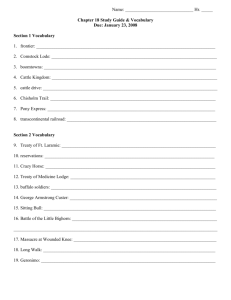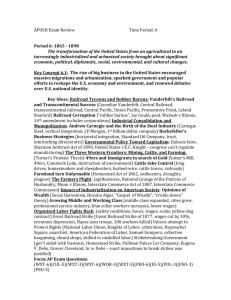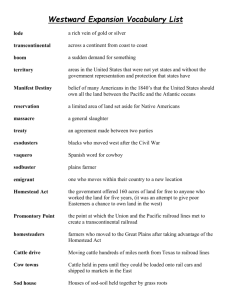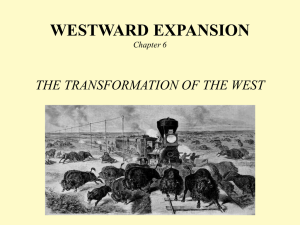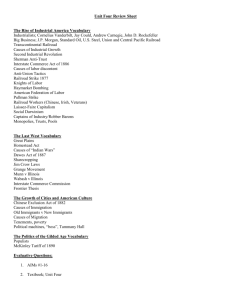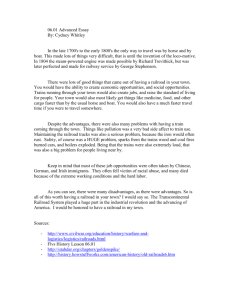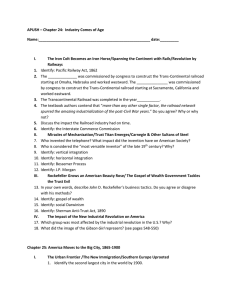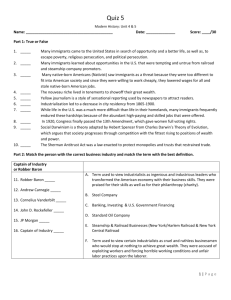Answer Key to Study Guide Chapters 4-7
advertisement
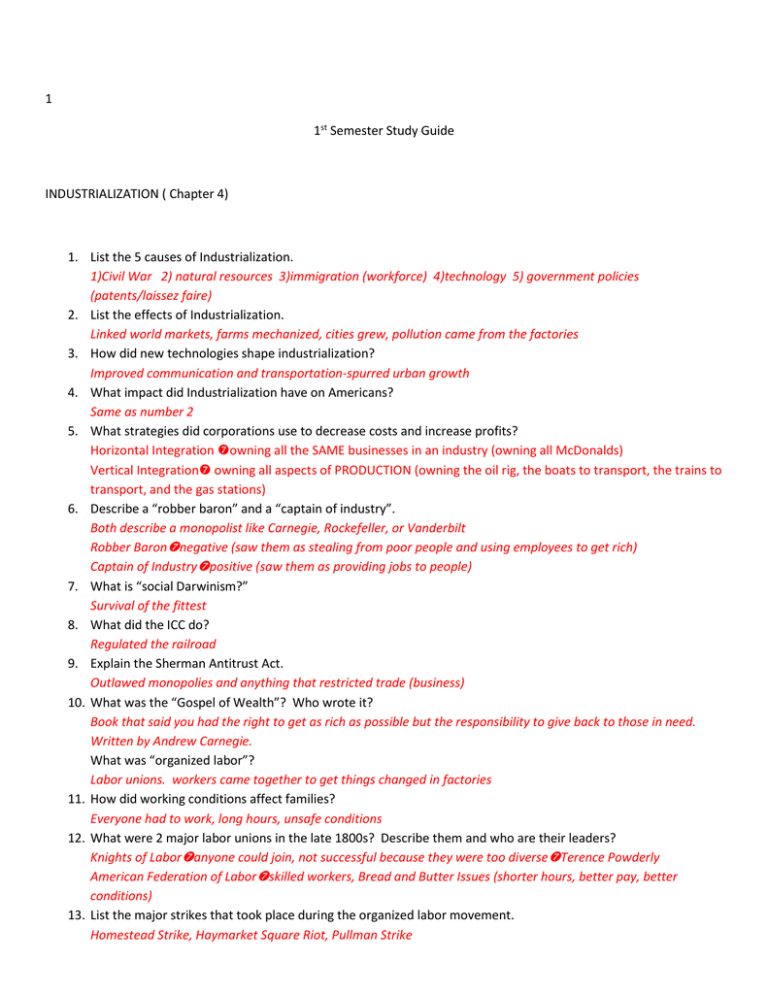
1 1st Semester Study Guide INDUSTRIALIZATION ( Chapter 4) 1. List the 5 causes of Industrialization. 1)Civil War 2) natural resources 3)immigration (workforce) 4)technology 5) government policies (patents/laissez faire) 2. List the effects of Industrialization. Linked world markets, farms mechanized, cities grew, pollution came from the factories 3. How did new technologies shape industrialization? Improved communication and transportation-spurred urban growth 4. What impact did Industrialization have on Americans? Same as number 2 5. What strategies did corporations use to decrease costs and increase profits? Horizontal Integration owning all the SAME businesses in an industry (owning all McDonalds) Vertical Integration owning all aspects of PRODUCTION (owning the oil rig, the boats to transport, the trains to transport, and the gas stations) 6. Describe a “robber baron” and a “captain of industry”. Both describe a monopolist like Carnegie, Rockefeller, or Vanderbilt Robber Baronnegative (saw them as stealing from poor people and using employees to get rich) Captain of Industrypositive (saw them as providing jobs to people) 7. What is “social Darwinism?” Survival of the fittest 8. What did the ICC do? Regulated the railroad 9. Explain the Sherman Antitrust Act. Outlawed monopolies and anything that restricted trade (business) 10. What was the “Gospel of Wealth”? Who wrote it? Book that said you had the right to get as rich as possible but the responsibility to give back to those in need. Written by Andrew Carnegie. What was “organized labor”? Labor unions. workers came together to get things changed in factories 11. How did working conditions affect families? Everyone had to work, long hours, unsafe conditions 12. What were 2 major labor unions in the late 1800s? Describe them and who are their leaders? Knights of Laboranyone could join, not successful because they were too diverseTerence Powderly American Federation of Laborskilled workers, Bread and Butter Issues (shorter hours, better pay, better conditions) 13. List the major strikes that took place during the organized labor movement. Homestead Strike, Haymarket Square Riot, Pullman Strike 2 14. What did these strikes have in common and what did it do to the public’s opinion of labor unions? Violence 15. Describe what took place during the Pullman Strike. Interrupted the delivery of the mail. Government sided on big business sending the message that they don’t care about workers. 16. What is a tariff? Explain who it was intended to protect and how. Tax on imported goods. Intended to protect American business because foreign goods would become more expensive to buy 17. What are subsidies? Government incentives to a business such as land or money IMMIGRATION AND URBANIZATION (Chapter 5) 18. Describe the “new” immigrants. No English, No Money, No Skills Had a harder time assimilating than old immigrants 19. List the push and pull factors for immigrants. Push (negatives)religious persecution, famine, war Pull (positive)land, money, jobs, families already here 20. Describe what happened to immigrants when they arrived at both Ellis Island and Angel Island. Ellis Island (Europeans)Easy to get through Angel Island (Asians)designed to filter out Chinese 21. What does assimilate mean? Blending into another culture (example: becoming more American) 22. What is nativism? Dislike for someone not born in America 23. Why did some Americans want to restrict Immigration? Threat of immigrants taking American jobs 24. Who was the first group to be excluded from immigrating to the United States? Chinese 25. How did cities use their land more effectively? Build skyscrapers 26. Give examples of mass transit. Subways, trolleys 27. How did mass transit change urban areas? Middle and upper class were able to move to suburbs, cities were less crowded and cleaner 28. Describe the living conditions of many urban dwellers. Unsanitary and dangerous 29. Who coined the term “Gilded Age”? Mark Twain 30. Why was this name appropriate for the time period? 3 31. 32. 33. 34. 35. From the outside, the time period seemed great but in reality, it was full of corruption and life in the city was far from glamorous What is William Randolph Hearst known for? Newspaper journalist Who wrote “Rags to Riches”? Horatio Alger What was the book about? Starting poor and becoming rich How did “Rags to Riches” encourage immigration? They thought they could do this as well What new forms of entertainment began in the late nineteenth century? Vaudevilles, baseball, boxing, Buffalo Bills Wild West Show THE SOUTH AND WEST (Chapter 6) 1. What new industries could be found in the South? Coal, iron and steel manufacturing 2. What type of transportation was key to industrialization? Railroad 3. Why did the South struggle to industrialize? Not enough money or workers 4. What crop dominated agriculture? cotton 5. What was the Farmers’ Alliance? Group of organized farmers that wanted government ownership of railroads 6. What amendments changed African American’s legal status? 13slaves are free 14equal protection and more 15men in line (vote) 7. What group used terror and violence to intimidate blacks in the South? KKK 8. Explain how Native American cultures were diverse. Geography determined their way of life (hunters or gatherers, etc) 9. What was the common thread among all tribes? Nature was sacred 10. Where were Indians’ forced to move by the government? reservations 11. List three circumstances that hurt the Native Americans. Reservations, disease, and killing of buffalo 12. What was the first instance of Americans/Indian warfare? Sand Creek Massacre 13. Why did tensions exist between settlers and Indians? Fight over land 4 14. Which battle was a victory for the Native Americans? Battle of Little Big Horn 15. Who led the Sioux Indians during this battle? Sitting Bull 16. What American General was killed at the Battle of Little Big Horn? Custer 17. Who said “I will fight no more forever”? Chief Joseph 18. What battle was fought over the Native Americans refusal to stop the Ghost Dance? Wounded Knee 19. What is significant about this battle? It was the final battle, the Indians gave up after this battle 20. What did policy makers hope that Indians would do as the buffalo became extinct? They would become farmers 21. What does assimilate mean? blending into another culture 22. Who wrote A Century of Dishonor? Helen Hunt Jackson 23. What was her book about? Mistreatment of Native Americans 24. What did the Dawes General Allotment Act (The Dawes Act) do? 160 acres of land to Indians 25. How did the Dawes ACt change the way Indians were treated? They wanted to assimilate them 26. What did people hope to find when they moved out WEst? Mining (gold and silver) 27. What is a Boom Town/Ghost Town? Boom Town town sprang up because mineral was discovered Ghost Towntown as abandoned because mineral was depleted 28. What is a vigilante? Self appointed law officer 29. Why did vigilantes come about? Western towns were lawless and dangerous 30. What was the Transcontinental Railroad? Railroad linking the East and West 31. How incentive did the government offer to convince railroad companies to build the Transcontinental Railroad? Land grants 32. What type of immigrants worked on the Transcontinental Railroad? Chinese 33. Describe the open-range system. No fences, cowboys wandered with their herds 34. How did ranchers tell their cattle apart with the open-range system? 5 35. 36. 37. 38. 39. 40. 41. 42. 43. 44. 45. branding Who were the original “cowboys”? Mexican Vaqueros What were cattle drives? Ranchers herded their cattle to the railroad What was a cow town? Towns on rail lines where ranchers brought their cattle to ship back east How did the railroad affect the cattle industry? Allowed for beef to be shipped back East What ended the open-range system? Barbed wire Define the Homestead Act. 160 acres of land to settlers What was the purpose of the Homestead Act? Encourage settlement out West Who were “Exodusters”? African Americans that moved out West What factors made life difficult for Homesteaders? Blizzards, no trees, loneliness, etc What was the purpose of the Morrill Act of 1862? Land to states to build agricultural teaching colleges (Mississippi State) What were some of the causes of prejudice and discrimination in the West? Some many diverse people coming together A lot of minorities in one place
